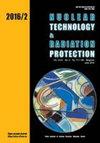放疗室的新设计建议——三波段迷宫
IF 0.9
4区 工程技术
Q3 NUCLEAR SCIENCE & TECHNOLOGY
引用次数: 0
摘要
本研究的目的是利用中子剂量学测量和蒙特卡罗模拟分析迷宫第二波段几何形状对中子剂量的依赖性,并在此基础上设计一种新的放射治疗室布局。在双波段迷宫治疗室中,仅对15 MeV的光子束进行了中子剂量测量。使用GEANT4工具包进行蒙特卡罗模拟。为了获得几何依赖性,我们在保持长、高、宽与现实相同的情况下,改变了第二波段的角度。结果表明,60?第二个迷宫的角度。比标准0?角。30 ?它缩小了30%,为90?小了10%。虽然最低剂量为30?带角随计算,对于临床应用不是很实用。临床上最有意思的是90?角度实际上是一个短的三波段迷宫,从中子辐射防护的角度来看,它可以提供一个紧凑的结构解决方案,并且可以更好地优化可用空间。本文章由计算机程序翻译,如有差异,请以英文原文为准。
Novel design of radiotherapy room suggestion - three-band maze
The objective of this study was to analyze the dependence of the neutron dose from the geometry of the second band of the maze using dosimetric measurements of neutrons and Monte Carlo simulations, and based on those results to design a novel radiotherapy room layout. Measurements of the neutron dose at a two-band maze therapy room were performed for a 15 MeV photon beam only. Monte Carlo simulations were performed using the GEANT4 toolkit. In order to obtain the geometry dependence, we were changing the second band angle while we kept the length, height, and width the same as in reality. Results show that the highest calculated dose was obtained for the 60? angle of the second maze. It is 17 % higher than for standard 0? angle. For 30? it was 30 % smaller and for 90? was 10% smaller. Although the lowest dose was obtained for 30? band angle with calculations, it is not very practical for clinical use. Clinically the most interesting would be the 90? angle which is practically a short three-band maze, which could be promising from the perspective of neutron radiation protection since it could offer a compact constructional solution, and better optimization of the available space.
求助全文
通过发布文献求助,成功后即可免费获取论文全文。
去求助
来源期刊

Nuclear Technology & Radiation Protection
NUCLEAR SCIENCE & TECHNOLOGY-
CiteScore
2.00
自引率
41.70%
发文量
10
审稿时长
6-12 weeks
期刊介绍:
Nuclear Technology & Radiation Protection is an international scientific journal covering the wide range of disciplines involved in nuclear science and technology as well as in the field of radiation protection. The journal is open for scientific papers, short papers, review articles, and technical papers dealing with nuclear power, research reactors, accelerators, nuclear materials, waste management, radiation measurements, and environmental problems. However, basic reactor physics and design, particle and radiation transport theory, and development of numerical methods and codes will also be important aspects of the editorial policy.
 求助内容:
求助内容: 应助结果提醒方式:
应助结果提醒方式:


